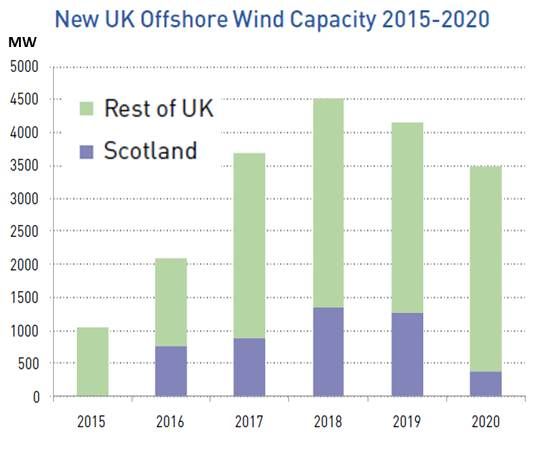Samsung Heavy Industries just made a 100-million-pound ($158 million) commitment to offshore wind in Scotland, where the harnessing of far-offshore, deeper-water wind was first proven. This investment in the future of offshore wind follows a 100-million-pound commitment from Mitsubishi Power Systems and a 40-million-pound ($63.3 million) commitment from Spanish wind turbine manufacturing giant Gamesa.
With Scotland’s 206-gigawatt offshore resource virtually untapped and the U.K.’s Crown Estate intent on building 30 gigawatts of ocean wind capacity by 2020, Samsung and the other two multinationals are betting that Scotland offers high winds, heavy industry and big returns.
The Crown Estate administers activity in the waters of the U.K.’s wide outer continental shelf. Ostensibly property of the British throne, revenues earned from offshore resources are, in fact, paid to the U.K. Treasury under the supervision of Parliament.
“Scotland has 60 percent of the U.K.’s onshore wind capacity,” explained Scotland Development International (SDI) Manager for Renewable Energy and Low Carbon Technologies Tom Lamb. But the U.K. has had difficulty finding sites for more onshore wind. “The U.K. government needs to develop renewables to meet its Kyoto targets,” Lamb explained, “and without offshore wind, it isn’t going to make it.”
In 2009, Scotland initiated the development of 5,700 megawatts of offshore wind at nine sites within the 12-mile boundary of its territorial waters. In 2010, the Crown Estate announced the development of 4,800 more megawatts in two zones beyond the 12-mile limit off Scotland’s eastern coast in the Firth of Forth.

Lamb noted that Scotland played a major role in the development of the U.K. offshore oil and gas industry in the North Sea during the 1980s and 1990s. He said the retired Beatrice Oil Field off Scotland’s northeastern tip was selected by the Crown Estate to test the feasibility of harvesting far-offshore, deeper-water winds, partly because it was one of the few offshore oil fields connected to the mainland grid. The Beatrice Wind Farm Demonstrator project, consisting of two gird-connected REpower five-megawatt turbines was completed in 2007.
Still operating, the Beatrice turbines have supplied valuable study data on offshore wind installation impacts such as noise, marine life and seabed habitat effects, ocean and migrating bird effects, commercial fishing and shipping interference, and aesthetic reactions.
The success of the Beatrice demonstration, Lamb said, led to the Crown Estate’s Round III offshore ambitions in deeper Atlantic and North Sea waters farther offshore than any previous undertakings.
The Beatrice project also anchored the manufacturing of offshore turbine substructures by Burntisland Fabrications (BiFAB) in Menthil, Fife. SDI and other Scottish development groups are now working to grow the Fife Energy Park near “impoverished areas on brownfield industrial land with quayside access,” Lamb explained. “In Samsung’s first move into European offshore wind,” he added, it will work at the Fife Energy Park “to design and test a seven-megawatt wind turbine already in engineering.”
BiFAB presently employs some 200 to 300 workers in a thriving manufacturing business serving Europe’s rapidly expanding ocean wind sector. Should the Samsung turbine go into production, Lamb said, it is projected to provide up to 500 jobs.
Gamesa’s commitment will lead to a research and development facility near Glasgow where it will work on its next generation of turbines. In doing so, it will be able to call on technical expertise from the U.K.’s only Doctoral Wind Energy Research Center at the University of Strathclyde. Mitsubishi will work on advanced drivetrain design in Edinburgh, calling on experts in renewable energy and fluid power research at the University of Edinburgh. “In both cases,” Lamb said, “we went out and pitched the companies and they came in.”

An underemployed Scottish workforce with experience in the fading North Sea offshore oil and gas industry and an underused infrastructure which was also serviceable in offshore oil and gas exploration and development are unique attractions to offshore wind developers.
Lamb said there is ongoing investment, now at 17 million pounds ($26.9 million), in upgrading the Methil site and nearby quay.
Scotland has also committed 330 million pounds to upgrading the 137-mile Beauly-Denny transmission system to increase its capacity and facilitate the carrying of onshore and offshore renewables.
A quarter of all the winds in Europe blow across Scotland. “The U.K.’s offshore development plans call for Scotland to have 10.5 gigawatts of offshore capacity by 2020,” Lamb said. Scotland’s government expects to obtain 80 percent or more of the country’s electricity from renewables by 2020.
Beyond developing its own offshore wind capacity, Lamb said, SDI wants Scotland to create a manufacturing center that will be a part of European wind’s massive infrastructure build out. EU plans call for up to half the continent’s electricity to come from offshore wind by mid-century. “To be a part of that,” Lamb said, “we had to bring turbine manufacturers into Scotland.”



